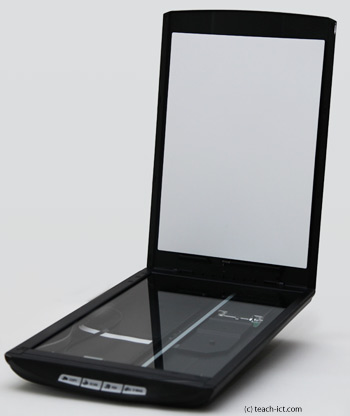8. Scanner
 Scanners can be used to convert images or text on paper into a digital format that can be used by the computer.
Scanners can be used to convert images or text on paper into a digital format that can be used by the computer.
A scanner works by shining a beam of light onto the surface of the object that you are scanning. This light is then reflected back onto a sensor that detects the colour of the light. This is then used to build up the digital image.
Items that are scanned are usually stored in an image format. However, special software - Optical Character Recognition - can be used to convert text on the paper into text which can be edited with a word processor. However, the text doesn't always get converted very well and you could end up with a lot of mistakes.
There are three types of scanner:
- Flatbed scanners
- Handheld scanners
- Specialist scanners
The most popular type is the flatbed scanner. This is shown in the picture above, that has its lid raised to show the glass surface where you place the item to be scanned. This is probably the one that you use at school. They can scan larger images and are more accurate than handheld scanners.
Handheld scanners are usually only a few inches wide and are held in the hand whilst they are rolled across the document to be scanned. The images produced are generally not as large or as high quality as those captured with a flatbed scanner.
If you are a photography enthusiast with a large collection of pre-digital 35mm negatives, then there are specialist scanners that can scan older 35mm film. In theory a standard scanner could do it but the film itself is relatively tiny and will result in very poor scans. The 35mm film scanner is exactly the same technology but the scan is set to go accurately over the 35mm range of the negative.
Another aspect of scanning is emotional - say you can scan the perfect reproduction of a loved family photograph. Question - do you then throw away the original photo? Only you can answer this question. But it does imply that there is something important about original documents - something that all the leading archive libraries in the world are having to deal with despite the state-of-the-art scanning process.
| Advantages of scanners | Disadvantages of scanners |
|---|---|
| Flatbed scanners are very accurate and can produce reasonably high quality images. | Images produced by the scanner can take up a lot of memory space. |
| Any image which is digitised by the scanner can then be included on electronic documents. | Images lose some quality in the scanning and digitising process. |
| Images once digitised can be enhanced with a graphics application. | The quality of the final image is dependent on the quality of the original image . |
| Specialist scanners can convert old material such as 35mm negatives into digital files. | Emotional value - is there value in the original image? |
| Can accurately capture an image, but the original source may be more important than the scanned image. |
Challenge see if you can find out one extra fact on this topic that we haven't already told you
Click on this link: Scanner
